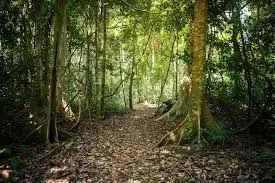Syllabus:
GS-3: Conservation, environmental pollution and degradation, environmental impact assessment
Context:
The global health of forests is worsening, and nations are far behind in meeting the 2030 goal to stop and reverse deforestation according to the Forest Declaration Assessment 2025.
Key Findings
Significant Global Forest Loss in 2024:
- In 2024, nearly 8.1 million hectares of forest were lost globally, exceeding the target needed to halt deforestation by 63%.
- Tropical primary forests were hardest hit, with a loss of 6.73 million hectares, resulting in the release of 3.1 billion metric tons of greenhouse gases.
Company Commitment to Deforestation Commitments: Only 3% of assessed companies are implementing strong deforestation commitments as expected.
Forest Loss in Key Biodiversity Areas:
- Between 2023 and 2024, forest loss within forested Key Biodiversity Areas (KBAs) surged by 47%, amounting to 2.17 million hectares lost.
- This dramatic increase has pushed global targets for zero tree cover loss by 2030 off track by 104%.
Key Reasons for Forest Degradation
Wildfire Impact on Forest Degradation: Wildfires have been identified as a leading cause of forest degradation, especially in the Amazon Basin, which has been severely affected by fire-induced damage, accelerating the decline of vital forest ecosystems.
Mining Threat to Forest Biodiversity: The mining sector is increasingly recognized as a significant threat to forests due to escalating energy demands.
Environmental Crime and Illegal Deforestation:
- Environmental crimes such as illegal logging and deforestation generate an estimated $281 billion annually.
- Between 61% and 94% of tropical deforestation for agricultural purposes is illegal, highlighting critical enforcement gaps.
Insufficient Forest Restoration and Policy Gaps: Despite escalating deforestation and degradation, forest restoration efforts are limited, covering only about 10.6 million hectares globally.
- Most governments have not effectively aligned their economic, trade, and land-use policies with forest conservation objectives, inhibiting meaningful progress.
Way Forward
- Mandatory Regulations and Accountability: Voluntary pledges must be replaced with legally binding regulations to ensure accountability in forest conservation and deforestation-free supply chains.
- Policy and Financial Alignment: Governments must integrate forest goals into economic, trade, and land-use policies, redirecting harmful subsidies and increasing financial support to scale up restoration and sustainable forest management.
- Empower Indigenous Peoples and Local Communities: Secure legal recognition of land tenure and active participation of Indigenous peoples and local communities in decision-making processes are critical to effective forest stewardship.
- Combat Environmental Crime: Strengthen law enforcement and international cooperation to tackle illegal deforestation and logging networks.
Forest Declaration Assessment
- It is an annual, peer-reviewed report assessing global forest progress, including deforestation, degradation, restoration, biodiversity, finance, rights, and governance.
- It was published by the Forest Declaration Assessment team and coordinated by Climate Focus.
- It was originally established as the New York Declaration on Forests (NYDF) Progress Assessment to monitor progress toward the NYDF’s 10 voluntary goals adopted at the 2014 UN Climate Summit.
Sources:
Down To Earth
Forest Declaration

